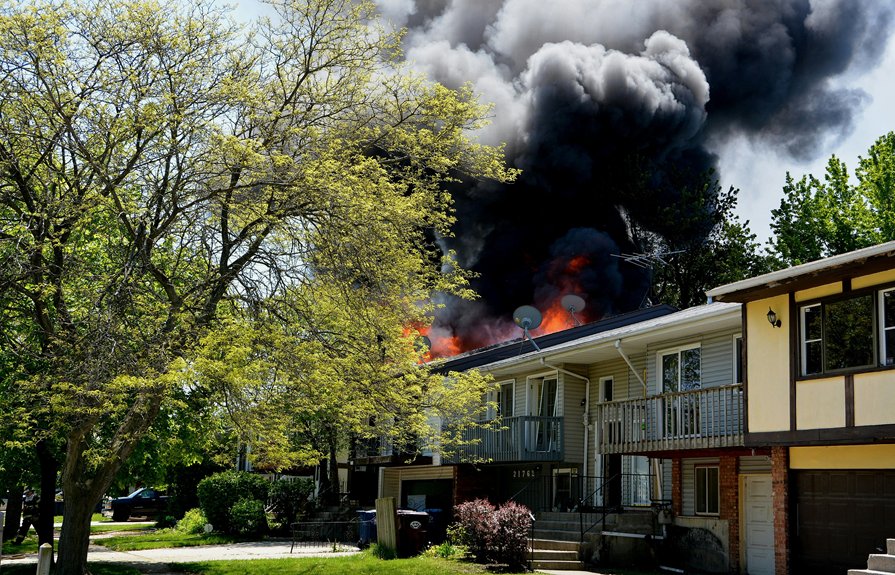When your roof sustains damage, understanding how your homeowner’s insurance may help can make a significant difference in managing repairs. While policies often cover sudden weather-related damage, they may not address issues caused by neglect or wear over time. Knowing what’s included—and what’s not—can prevent surprises and ensure you’re prepared to handle the costs. To navigate this process effectively, it’s important to comprehend the details of your coverage and the steps to file a claim.
Understanding Your Homeowner’s Insurance Policy
Understanding your homeowner’s insurance policy is essential because it determines what damage or loss coverage you have if your roof needs replacement. Carefully review the policy to identify any policy exclusions that might limit coverage, such as damage from neglect or specific weather events. Knowing these exclusions helps you set realistic expectations and plan accordingly. Additionally, consider premium considerations, as policies with broader coverage often come with higher premiums. Understanding how your premium might change with different coverage options allows you to balance cost and protection effectively. Being aware of storm damage roof repair options and coverage details can help you prepare for unexpected weather-related incidents.
Common Types of Roof Damage Covered by Insurance
When your roof sustains damage, insurance typically covers several common types of issues that compromise its integrity. Hail damage is a frequent cause of claims, as it can leave dents, cracks, and missing shingles that weaken your roof’s protection.
Wind storms are another major culprit, capable of tearing off shingles, causing uplift, or even damaging the underlying structure. These events often result in leaks, water intrusion, and further deterioration if not addressed promptly.
Insurance policies generally cover repairs or replacements caused by such weather-related damage, recognizing their unpredictability and severity. Keep in mind, documenting damage with photos and inspections is essential to make certain your claim is processed smoothly.
Understanding these common covered damages helps you act quickly and protect your home effectively.
What Situations Might Not Be Covered
While insurance covers many types of roof damage caused by weather events, there are situations where your policy mightn’t provide coverage. Damage from wear and tear over time is typically not covered, as insurance is meant for sudden, accidental damage.
If your roof deteriorates due to age or prolonged exposure, you likely won’t be reimbursed for repairs. Additionally, improper maintenance can void your coverage; neglecting regular inspections or neglecting repairs can be seen as negligence.
For example, missing shingles or clogged gutters that cause damage may not be covered if it’s determined you didn’t take proper care of your roof. Understanding these exclusions helps you avoid surprises and ensures you maintain your roof properly to protect your home.
The Claims Process for Roof Repairs and Replacements
Starting the claims process for roof repairs or replacement may seem intimidating, but knowing the steps can make it more manageable.
First, contact your insurance provider promptly after damage occurs. An adjuster will schedule a claims adjustment appointment to assess the damage and determine coverage.
During this inspection, be prepared to show evidence of damage and any relevant documentation. Keep in mind that coverage limitations might affect what the insurer agrees to cover, especially if the damage isn’t directly caused by a covered peril.
After the claims adjustment, your insurer will review their findings and notify you of the approved amount. If approved, they’ll guide you through the next steps for repairs or replacement.
Understanding this process helps you navigate your claim confidently and efficiently.
Tips for Documenting Damage and Filing Claims
Properly documenting damage is essential to ensuring your insurance claim proceeds smoothly. Begin with a thorough roof inspection to identify all affected areas.
Take clear, detailed photos of the damage from multiple angles, including close-ups of missing shingles or leaks.
Keep records of any repairs or temporary fixes you perform to prevent further damage.
When filing your claim, provide a detailed written description of the damage, referencing the inspection findings. Be honest and precise to avoid the risk of claim denial.
Stay organized by maintaining copies of all correspondence, photos, and receipts.
Accurate documentation helps your insurer assess the damage correctly and speeds up the process, reducing the likelihood of disputes or denial of your roof replacement claim.
How to Ensure Adequate Coverage for Future Roof Needs
To guarantee your insurance provides adequate coverage for future roof needs, it’s vital to review your policy regularly and update it as your home’s value or condition changes. Keep up with regular roof maintenance to identify potential issues early and prevent costly damages.
Document any repairs and improvements, as this can help support your claim if needed. When evaluating your coverage, consider your insurance deductibles and ensure they align with your financial ability to handle potential claims. Increasing your deductible might lower premiums but could mean higher out-of-pocket costs during a claim.
Staying proactive about roof maintenance and understanding your policy details ensures you’re prepared for future repairs, minimizing surprises and ensuring your coverage remains sufficient for your home’s needs.
Conclusion
By understanding your insurance policy, documenting damage thoroughly, and knowing what’s covered, you can make the claims process smoother and ensure you’re protected. Stay proactive by reviewing your coverage regularly and addressing any gaps before disaster strikes. This way, you’ll be ready to handle roof damage confidently, minimizing out-of-pocket costs and keeping your home secure. Being informed is your best defense against unexpected roofing expenses. For more information on how to schedule your free roof inspection, call us at (405) 543-2920 or visit us online at Top View Roofing.











